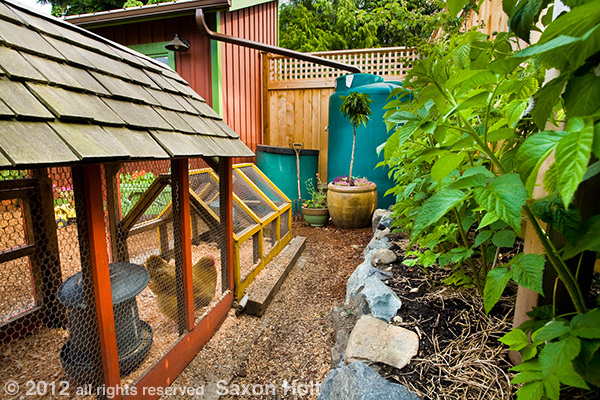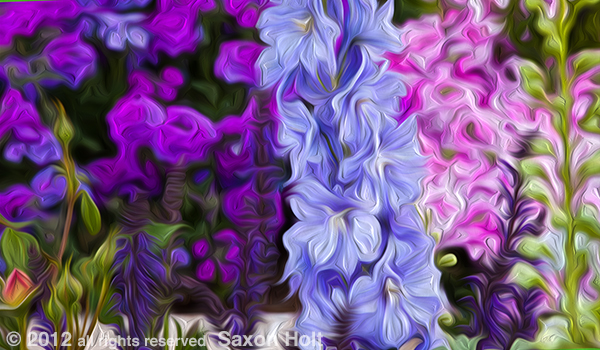
This photo of tall succulents in a narrow bed against a white stucco wall was taken in bright sun to accent the shadows. The intriguing composition is meant to provoke thinking about plant design and sun light.
A good garden photo is more than a nice composition, it should tell a story. Sometimes the story is no more than communicating good garden technique, for which all our lessons thus far on composition, balance, framing, and light help the photographer concentrate on simply expressing garden appreciation.
Other times we want to provoke the viewer to take a closer look at our images and see an impression, an interpretation, a unique expression that intrigues us and we want others to see and think about. This can be done with unexpected elements:

For this garden project installation “The Grow-Melt Project”, I photographed looking directly into the sun to emphasize the melting block of ice. Whether or not this project is about the earth heating up or the preciousness of water or any other idea, is unimportant to the photograph. The photo provokes us to look closely and wonder what it means.
Or we can provoke with whimsical elements:

“A Place to Dream” – a bit of garden whimsy causes us to question our assumptions on just what a garden bed can be.
And increasingly we can provoke with digital manipulation.
This episode in the PhotoBotanic Garden Photography Workshop covers a wide range of ideas to provoke and inspire viewers, including image manipulation which we will go on to cover in much more depth in Chapter 4. We begin to move beyond the picture itself toward the overarching idea that our photographs are intentional and they tell a story.
As we hone the craft of garden photography some of the most fun and satisfying photos are those that we imbue with our own meaning, where the garden reveals an insight and we want to share. This is the excitement of photography – to find meaning and communicate in a way that is our own, in a way that provokes and intrigues.

Ceramic sculptures: “Bambusa ceramica” displayed in the garden of artist Marcia Donahue. Whether or not we know what this photo is about, we are intrigued to look closer and provoked to wonder about it.
As garden photographers we have an edge in that our audience wants to appreciate what we do. Our audiences are gardeners, or at least those that want to appreciate gardens in some way. In deciding on what photos to take and which ones to share, we can assume the viewer will know that the inspiration began in a garden. We also must assume our audience will understand there is intention behind the photos and hope they are intrigued enough to look carefully.

If the viewer is intrigued enough to look at this photo carefully, the morning light streaming through these trees is clearly in a garden. Note the ceramic pot used as a focal point.
I will tell you this next photo is a marvelous example of a sustainable garden. Now I’ve got you. You are a gardener and you will want to study the photo.

A gardener who is intrigued enough to study this photo will find all the elements of a sustainable garden – compost pile, cistern with rain gutter, chickens, berries growing in rich organic soil. A non gardener is not likely to give the photo a close look.
In my own work, knowing my audience appreciates gardens has allowed me to experiment more and more with digital tools and techniques. And with my changing eyesight I do increasingly see gardens as impressions. I need these new tools to push myself to find new ways to tell the intriguing new stories I find.

Photoshop filters make these delphiniums in a summer flower border into impressionistic blocks of colors and shapes that are more important to the photo than the actual flowers themselves.
I want to find ways to draw viewers in to my photos, to provoke them to wonder.
It is easy to overdo the digital manipulation that might be seen as tricks that turn viewers away. On the other hand it is simply fun to play with the new digital filters and apps. Do it for yourself. Do it to put a photo on your own wall (either real or virtual…). The first person to please with your photograph is yourself.

With digital tools this red grape leaf in glorious color loses its context on my back fence. Is it still a garden photo ?
These techniques are tools of artistic expression and much more how-to will be discussed later. But as you develop your own style, your own vision, and your own way of communicating, trust your eye, see with intention, use all the tools the camera offers to provoke and intrigue.
However don’t lose sight of the old adage about using special techniques to enhance a photo: garbage in – garbage out. Your photo needs to be strong, well composed, and intentional. Have a story to tell, know what you want to say. Without that understanding, any technique you use will simply confuse – and provoke a reaction you don’t want.

